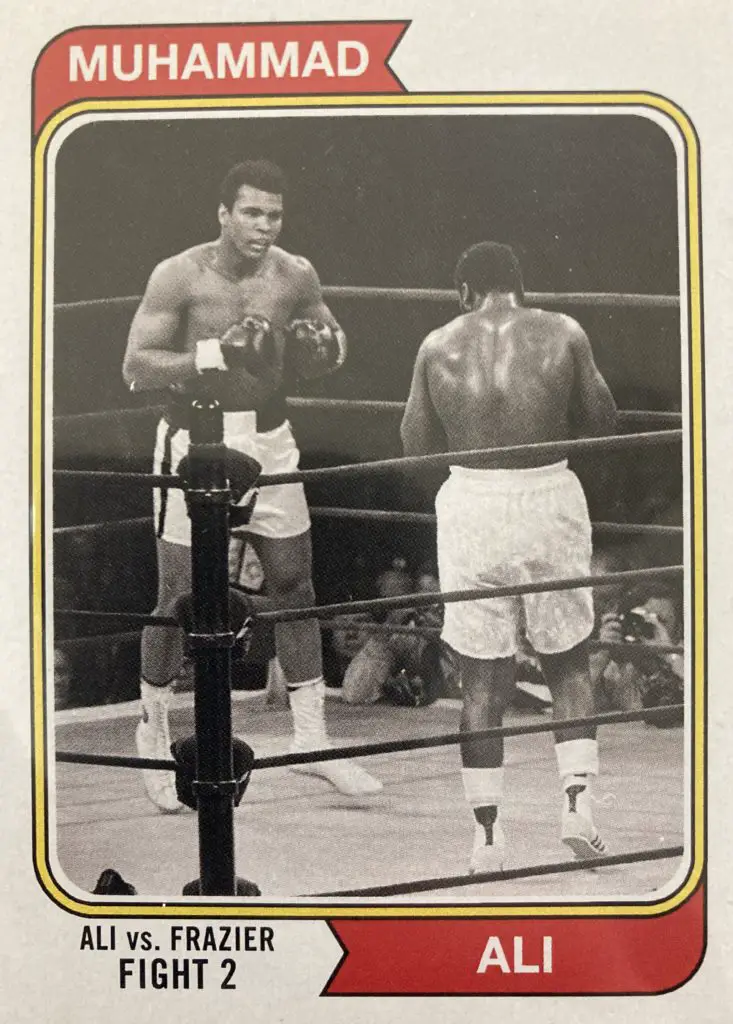Boxing cards are a type of trading card game where players collect and trade cards featuring boxers from around the world.
Boxing cards have evolved significantly over the years. They started out being just about the fighters themselves with little or no information on them. Over time, however, the amount of information included on each card has grown.

Each year, new sets of cards are released that feature new boxers. And also new features such as autographs, rookie cards, and memorabilia cards. We look at boxing cards in closer detail. Tell you all about them, how to collect them and where it all started.
What Are Boxing Cards?
Boxing cards are a type of collectible card game (CCG). They allows players to collect and trade cards featuring various boxers from around the globe. These cards can be used to build up a collection based on individual boxers or teams of boxers.
Boxing cards have been around since the late 1800s. However, they did not become popular until the early 1900s when the sport became more mainstream. Before this point, people would collect baseball cards, football cards, and basketball cards.
But once the sport became more popular, people wanted to collect something else.
Boxing cards were perfect because they were easy to find and could be easily traced. Many different companies made these cards.
Some of them were named after their main sponsors such as the American Tobacco Company, the National Bantam Athletic Association, and the National Sporting Goods Manufacturers Association.
Other companies were named after the specific boxer they represented. For example, the Leo Houck Company made cards for Leo Houck.
In addition to sponsoring boxing matches, some companies also sponsored prizefights. These prizes included cash, cars, and houses.
Many of these cards came with a certificate of authenticity. Which stated that the card was authentic and that it was signed by the boxer himself. Most of these certificates are now worth quite a bit of money on eBay.
Card Sets
Boxing cards can be found in two different formats. One format is called the “boxing card set” and the other is called the “boxer card set.” A boxing card set contains only one type of card while a boxer card set contains multiple types of cards.
The most common type of boxing card is the “record card.” Record cards contain information about the boxer including his name, weight class, hometown, date of birth, and record.
Another common type of boxing card is the “boxing pictures.” These cards feature photographs of the boxer taken during training sessions or actual fights. The final type of boxing card is called the “autograph card.”
Autographs cards are usually the same size as record cards but they do not include any text. Instead, they feature the signature of the boxer along with their nickname.
Collecting Boxers
You will probably start by purchasing a few packs of cards. After you purchase your initial collection, you will then begin to collect the rest of the cards. The easiest way to get started is by ordering cards online through eBay.
This is especially helpful if you live outside of the United States. If you live in the U.S., you might consider buying cards at local flea markets, garage sales, or certain memorabilia outlets.
Once you have collected enough cards, you may want to take them to a showroom where you can trade them for other cards. Showrooms are great places to meet fellow collectors and talk about your hobby. They often have events where you can trade cards and buy new ones.
There are several ways to collect boxers. You can collect them based on their record, their nationality, or their weight class. Collecting boxers from every country is a good way to expand your collection. It is also fun to collect boxers who hold world records.
Weight Class
Another way to collect boxers involves focusing on a specific weight class. There are four primary weight classes: featherweight (118 lbs), lightweight (135 lbs), welterweight (147 lbs), and heavyweight (160 lbs).
Fighters who compete in these weight classes are known as lightweights, middleweights, welters, and heavies respectively.
Lightweights fight in the 118 lb weight class, middleweights fight in the 147 lb weight class, welters fight in the 160 lb weight class, and heavies fight in the 175 lb weight class.
History Of Boxing Cards
How Did It Begin?
From the 1880s to 1895, classic sets of boxing cards were issued by cigarette companies such as Goodwin & Co.
The second boxing issue from Goodwin debuted in 1887, and people recorded small, blank-backed album photographs with Old Judge and Gypsy Queen branding.
Other tobacco cards followed, covering more in-depth info, and the first great wave of cards petered out in 1895.
After this, tobacco card production ended and was not about for 15 years. This meant a stop on boxing cards as well. Between 1895 and 1905, there were a couple of cabinet cards and postcards but nothing else until tobacco cards resurfaced in 1909.
Candy Cards
Tobacco marketers were followed by candy makers, and in the years between 1909 to 1912, hundreds of boxing cards were being produced. At the start of the American contribution to World War I, however, the first epoch of the new card age came to a finish.
Boxing card production started again when the war ended, using candy and strip cards, but never really returned to how they were issued before. In 1921, the Exhibit Supply Company of Chicago started issuing boxing cards in arcade machines and as over-the-counter postcards.
There were only four cards issued in a multisport set and the only major prewar issues in the 1930s were from Goudey. The other issues of the time were strip cards, aimed at kid collectors. Exhibits and strips were the main issues of the 1920s for a long time after this.
After the Second World War, the Silver Age of cards started with the 1948 issues, but boxing cards weren’t among the offerings from gum manufacturers.
Beyond the issues from Bowman, Leaf, and Topps, there were few American boxing cards available.
This could be to do with the rise of baseball and football and other televised sports, and the low place boxing fell to when there was the widespread revelation of the Mob’s role in boxing throughout the ages.
Heavyweights champs
When the 1970s came and heavyweight champions surfaced, such as Ali, Foreman, and others, the cards started to decrease in production even more. However, boxing fans now have a giant portfolio of cards issued over 100 years in the past.

Boxing cards managed to cross racial barriers before the rest of American society, helped the Americanization of the country’s immigrants, and memorialized the exploits of men with nicknames like Two-Ton Tony, Newsboy, Kid, the Black Diamond, and more.
Final Thoughts
We hope you enjoyed our look into what boxing cards are and the history of boxing cards. We’ve covered everything from the earliest days of the sport through to the present day.
Boxing cards are a great way to learn about the sport and its history, as well as grow a collection you are proud of. What are you waiting for? Start collecting today!
- Mac Jones Rookie Cards – Our favorite picks - October 21, 2022
- FOTL Sports Cards: What It Means, And Why You Should Care - October 17, 2022
- Best Picks For Juan Gonzalez Rookie Cards - October 3, 2022

